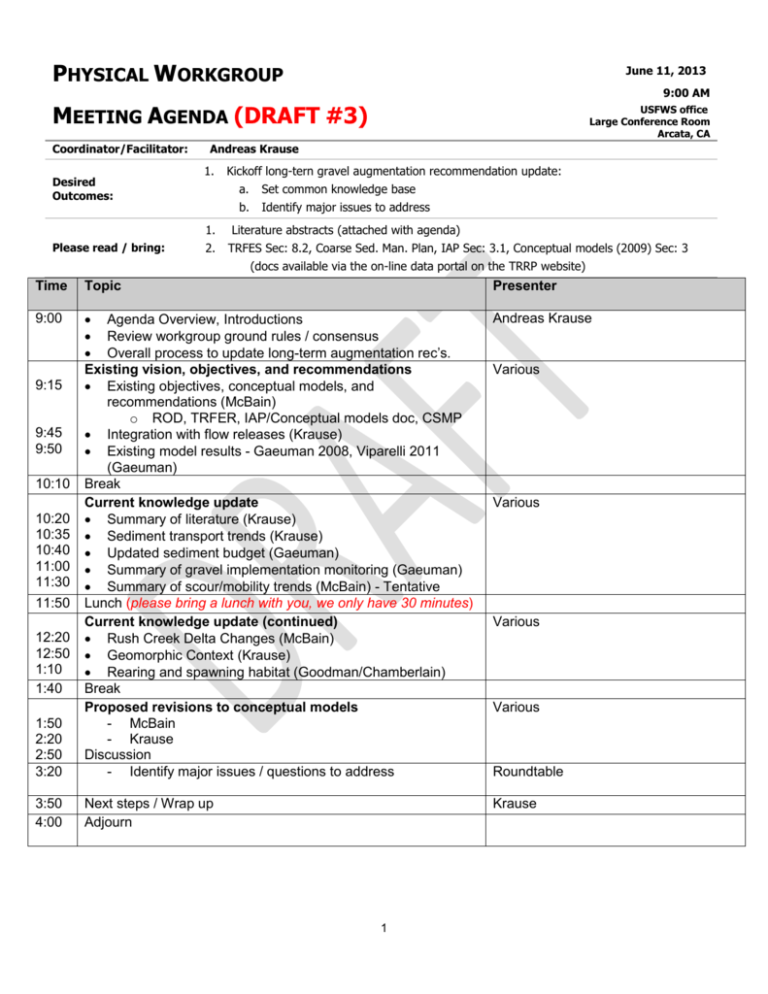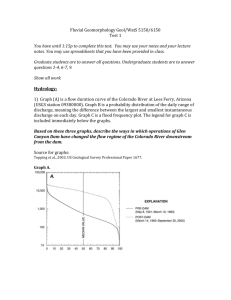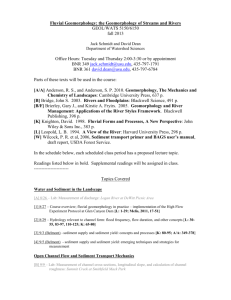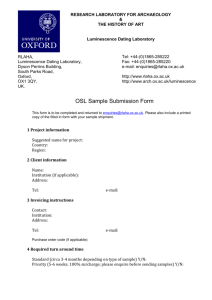
PHYSICAL WORKGROUP
June 11, 2013
9:00 AM
MEETING AGENDA (DRAFT #3)
Coordinator/Facilitator:
Desired
Outcomes:
Andreas Krause
1.
1.
Please read / bring:
USFWS office
Large Conference Room
Arcata, CA
2.
Kickoff long-tern gravel augmentation recommendation update:
a.
Set common knowledge base
b.
Identify major issues to address
Literature abstracts (attached with agenda)
TRFES Sec: 8.2, Coarse Sed. Man. Plan, IAP Sec: 3.1, Conceptual models (2009) Sec: 3
(docs available via the on-line data portal on the TRRP website)
Time
Topic
Presenter
9:00
Andreas Krause
1:50
2:20
2:50
3:20
Agenda Overview, Introductions
Review workgroup ground rules / consensus
Overall process to update long-term augmentation rec’s.
Existing vision, objectives, and recommendations
Existing objectives, conceptual models, and
recommendations (McBain)
o ROD, TRFER, IAP/Conceptual models doc, CSMP
Integration with flow releases (Krause)
Existing model results - Gaeuman 2008, Viparelli 2011
(Gaeuman)
Break
Current knowledge update
Summary of literature (Krause)
Sediment transport trends (Krause)
Updated sediment budget (Gaeuman)
Summary of gravel implementation monitoring (Gaeuman)
Summary of scour/mobility trends (McBain) - Tentative
Lunch (please bring a lunch with you, we only have 30 minutes)
Current knowledge update (continued)
Rush Creek Delta Changes (McBain)
Geomorphic Context (Krause)
Rearing and spawning habitat (Goodman/Chamberlain)
Break
Proposed revisions to conceptual models
- McBain
- Krause
Discussion
- Identify major issues / questions to address
3:50
4:00
Next steps / Wrap up
Adjourn
Krause
9:15
9:45
9:50
10:10
10:20
10:35
10:40
11:00
11:30
11:50
12:20
12:50
1:10
1:40
1
Various
Various
Various
Various
Roundtable
LITERATURE ABSTRACTS FOR REVIEW PRIOR TO MEETING
(in alphabetical order)
Bartley, R. and I. Rutherfurd (2005). "Measuring the reach-scale geomorphic diversity of streams: Application to a
stream disturbed by a sediment slug." River Research and Applications 21(1): 39-59.
There is increasing evidence that greater physical diversity in a stream leads to a greater diversity of habitats,
and hence species. Human impact has reduced the physical diversity within many stream systems. This paper
reviews a range of techniques used to measure the physical diversity of a stream reach and specifically examines
variability measures of a stream's thalweg, cross-section and sediment size at the scale of millimetres to metres.
Each measure was evaluated against synthetic data with different levels of diversity. From the original thirteen,
eight measures were considered appropriate for application to data measured in the field. Creightons Creek
(Victoria, Australia) was selected as a test site as it contains areas that are in their original geomorphic condition,
as well as sections that have been disturbed by increased bed-load in the form of a sediment slug. All eight
measures showed that the area impacted by the sediment slug was less diverse in terms of its geomorphic
variability than the unimpacted reaches. This suggests that massive increases in sediment load to streams will
reduce the geomorphic complexity of a stream, and in turn, the diversity of habitat for biological communities.
Copyright (C) 2005 John Wiley Sons, Ltd.
Bartley, R. and I. Rutherfurd (2005). "Re-evaluation of the wave model as a tool for quantifying the geomorphic recovery
potential of streams disturbed by sediment slugs." Geomorphology 64(3-4): 221-242.
A central principle of stream rehabilitation is that managers should accelerate the 'natural' recovery of degraded
savants. In this paper, we explore the 'recovery' of channel morphology behind translating sediment waves
using an observed/expected space for time substitution (SFTS) model. Channel 'recovery' is defined by the
variability of the thalweg. cross-sections and bed sediments. Of the three streams investigated in SE Australia,
one followed die general response described by Gilbert's classic wave model with the stream bed returning to its
pre-disturbance geomorphic variability as the sediment wave passed. In this case, the recovery did not
necessarily decline gradually with the distance away from the peak of the slug, instead the geomorphic
variability remained low within the slug, and then increased dramatically once the slug evacuated. By contrast.
the other two streams continued on their pre-slug trajectory of channel incision, which has not allowed
geomorphic variability to establish once the sediment slug has passed. The three study streams showed
different recovery responses to a relatively simple pulse of sediment, (C) 2004 Elsevier B.V. All rights reserved.
Gaeuman, D. (2008). Recommended quantities and gradation for long-term coarse sediment augmentation downstream
from Lewiston Dam, Trinity River Restoration Program.
Gaeuman, D. (2013). "High-flow gravel injection for constructing designed in-channel features." River Research and
Applications.
A planned gravel bar was dynamically constructed at a river rehabilitation project site through a
combination of mechanical channel
reconfiguration and high-flow gravel injection. Mechanical alterations intended to promote deposition in a
target area were followed by the injection
of 1570m3 of gravel and small cobble 400m upstream during a high-flow dam release. This dynamic bar
construction proved successful in
that bed elevations increased locally by more than 1m in the target area and a new alternate bar sequence was
created nearby. Morphodynamic
modelling used to plan the injection correctly identified general areas prone to deposition or scour, but did not
correctly predict the magnitudes
of change or resolve features at the scale of individual alternate bars. A flow perturbation induced by a
constructed meander bend just upstream
from the injection point may have contributed to alternate bar development. Despite the observed bar
development, sediment budget calculations
2
indicate that the quantity of gravel stored in the target reach remained constant, perhaps because of an
interruption in the delivery of bed material
fromupstream. The estimated gravel load over the release increased steadily in the downstreamdirection and, at
the downstreamstudy area boundary,
had attained a magnitude 4.6 times larger than the quantity of injected gravel. These results demonstrate that
bedload entrainment from the
channel perimeter dominated the gravel supply to downstream reaches and suggest that the gravel injection
had little effect on geomorphic adjustments
downstream from its target area.
Harrison, L. R., C. J. Legleiter, et al. (2011). "Channel dynamics and habitat development in a meandering, gravel bed
river." Water Resources Research 47: 21.
We investigated how channel morphology, flow complexity, and habitat characteristics in a meandering gravel
bed river evolved over time from a simple, reconfigured initial condition. Using a time series of topographic
data, we measured rates of channel migration and morphologic change, documented patterns of sediment
storage, and estimated rates of sediment supply. We constructed, calibrated, and validated hydrodynamic
models to quantify how the evolving morphology influenced hydraulic conditions, flow complexity, and habitat
suitability for Chinook salmon spawning and rearing. For a series of meander bends with constant curvature,
similar bank materials, and an identical flow history, sediment supply and bar storage directly influenced
channel migration rates. Habitat modeling indicated that the availability of Chinook salmon spawning habitat
increased over time, whereas the majority of the reach continues to provide only low-to medium-quality rearing
habitat for juvenile salmonids, primarily because of a lack of low-velocity refuge zones. However, other metrics
of flow complexity indicate that areas of favorable flow conditions gradually expanded as point bars developed
along the inner bank of each bend. These results indicate that although sediment supply can stimulate channel
change and diversify river morphology, which acts to promote flow complexity and provide spawning habitat,
these sediment-driven morphological changes might not create bioenergetically favorable habitat for juvenile
salmonids.
May, C. L. and B. Pryor (2013). "Inital Motion and Bedload Transport Distance by Particle Tracking in a Large
Regulated River." River Research and Applications.
Reservoir releases on large regulated rivers are increasingly being used to rejuvenate riverine habitat downstream
of dams. Determining the effective flow level is complicated by the trade-off between mobilizing bed particles
and retaining coarse sediment in rivers with low sediment supply. This study determined mobilization and
transport distance of bed particles using motion-sensing radio transmitting particles that approximated the reachaverage D84 grain size. The distribution of shear stress at initial motion varied substantially between flood events,
and suggests that the sequence of flood events and the history of under-threshold flows may be an important
determinant of bed strength and thus particle mobility. In addition, particle activity was greatest on the rising limb
of each flood and was maximized at near bankfull flow. Travel distances did not vary between floods when scaled
by transport event duration, and a negative exponential distribution was a good fit to the data. Results of this study
provide important insight into individual particle movement, which can be used to inform flow releases and
understand the effects of flood magnitude on particle mobility and transport.
Podolak, C. P. (2012). Channel bed response to an increased sediment supply. Department of Geography and
Environmental Engineering. Baltimore, MD, Johns Hopkins University. Ph.D: 131.
This dissertation presents a suite of field observations, flume measurements, and numerical
models investigating the response of channel beds to an increased sediment supply.
Monitoring the Sandy River, Oregon following removal of the Marmot Dam provides
measurements of response to a five-fold sediment supply increase. Where supply increase
was the greatest, bed slope became steeper and bed topography became less variable.
Reaches with less aggradation responded primarily with bed surface fining. During the
initial stages of deposition the bed configuration bore little resemblance to the pre-removal
3
configuration, however, after one year, the planform regained the pre-removal pattern.
In a recirculating field-scale flume with alternate bar topography, sediment supply
was increased by manually augmenting the sediment supply in two steps such that the final
bed transported three times as much as the initial bed. The initial and final bed topography
and texture were very similar and included long stationary alternate bars. The transient
bed was very different, dominated by several scales of shorter wavelength migrating
bedforms. Further, the adjustment in topographic and textural patterns continued after the
bed slope and mean sediment transport had approached steady state.
A one-dimensional (1-D) morphodynamic model predicted steady state slope and
transport rates for the flume experiments, but it over-predicted the rate of adjustment.
Comparison of 1-D model results with flume observations demonstrated the importance
of 2-D adjustments related to the spatial variability of topography and texture.
The ensemble of field, flume, and numerical models highlight four bed responses
to sediment supply – changes to the mean and distribution of both bed topography and
texture. Adjustments can operate on different time scales, with grain size most likely to
respond first. Spatial patterns of topography and texture can adjust to convey an elevated
sediment supply without an increase in bed slope. Where slope increases are the dominant
response, spatial patterns of topography and texture may moderate the slope effects,
introducing systematic errors in one-dimensional model predictions.
Runge, M. C., S. J. Converse, et al. (2011). "Which uncertainty? Using expert elicitation and expected value of
information to design an adaptive management program." Biological Conservation 144: 1214-1223.
Natural resource management is plagued with uncertainty of many kinds, but not all uncertainties are
equally important to resolve. The promise of adaptive management is that learning in the short-term will
improve management in the long-term; that promise is best kept if the focus of learning is on those
uncertainties that most impede achievement of management objectives. In this context, an existing tool
of decision analysis, the expected value of perfect information (EVPI), is particularly valuable in identifying
the most important uncertainties. Expert elicitation can be used to develop preliminary predictions of
management response under a series of hypotheses, as well as prior weights for those hypotheses, and
the EVPI can be used to determine how much management could improve if uncertainty was resolved.
These methods were applied to management of whooping cranes (Grus americana), an endangered migratory
bird that is being reintroduced in several places in North America. The Eastern Migratory Population
of whooping cranes had exhibited almost no successful reproduction through 2009. Several dozen
hypotheses can be advanced to explain this failure, and many of them lead to very different management
responses. An expert panel articulated the hypotheses, provided prior weights for them, developed
potential management strategies, and made predictions about the response of the population to each
strategy under each hypothesis. Multi-criteria decision analysis identified a preferred strategy in the face
of uncertainty, and analysis of the expected value of information identified how informative each strategy
could be. These results provide the foundation for design of an adaptive management program.
Venditti, J. G., W. E. Dietrich, et al. (2010). "Mobilization of coarse surface layers in gravel-bedded river by finer gravel
bed load." Water Resources Research 46.
Additions of sand to gravel beds greatly increase the mobility and flux of gravel.
However, it is not known how additions of finer gravel to coarser gravel beds will
affect the mobility of bed material. Here we examine the effect of fine gravel pulses
on gravel bed material transport and near‐bed flow dynamics in a series of flume
experiments. Bed material refers exclusively to sediment in the channel prior to the
pulse introduction. The observations indicate that fine sediment pulses tend to migrate
downstream in low‐amplitude waves. As the waves pass over the gravel bed, the
interstitial pockets in the bed material surface fill and coarse gravel particles are entrained.
This increases bed material transport rates and causes a distinct shift from a selective
4
mobility transport regime where particles coarser than the bed material median (8 mm)
make up <30% of the load to an equal mobility transport regime where bed materials
coarser than 8 mm and finer than 8 mm are transported in equal proportions. The
only possible source for this coarser bed load material is the sediment bed, suggesting that
portions of the coarse surface layer are being mobilized. Observations of near‐bed velocity
and turbulence suggest that fine gravel pulses cause fluid acceleration in the near‐bed
region associated with a reduction in the level of turbulence produced at the sediment
boundary. This accelerated fluid at the bed increases drag exerted on coarse surface layer
particles, promoting their mobilization. Our findings suggest that, in general, finer bed
sediment (not just sand) can mobilize coarser sediment and that expressions for the
influence of sand on bed mobility need to be generalized on the basis of grain ratios.
Venditti, J. G., W. E. Dietrich, et al. (2010). "Effect of sediment pulse grain size on sediment transport rates and bed
mobility in gravel bed rivers." Journal of Geophysical Research 115(in proof).
Sediment supply to gravel bed river channels often takes the form of episodic sediment pulses, and there is
considerable interest in introducing sediment pulses in stream restorations to alter bed surface grain size
distributions and bed mobility. A series of laboratory experiments was conducted in order to examine how
sediment pulse grain size and volume affects the mobility of bed material in gravel bed channels. Pulses used in
the experiments were composed of either the fine tail or the median of the subsurface bed material grain size
distribution. Bed material refers to sediment in the channel prior to the pulse introduction exclusively. Both
types of pulse were finer than the bed material surface median. Two pulse sizes were used, which were either
equivalent to the volume of sediment required to cover the entire bed one median subsurface bed material
grain diameter deep (full unit) or 1/4 of this volume (1/4 unit). The latter was designed to produce a transitory
pulse. With the exception of the 1/4 unit coarse pulse, introduction of the sediment pulses to the channel
caused dramatic increases in the bed load flux. The coarse sediment pulses fine the bed surface and coarsen the
bed load. Finer pulses also fine the surface, but the bed load fines while the bed material load (that excludes
pulse material) coarsens. The greatest effects on the fractional transport occurred during the full unit fine pulse
where the pulse covered the greatest bed surface and effectively smoothed the bed, increasing near bed
velocity and mobilizing the coarse particles. Overall, the coarse pulses were not very effective at mobilizing bed
material. The large fine pulse mobilized ∼35% of the bed material surface (∼35% of its input weight) and was
most effective at mobilizing the surface. However, the small fine pulse mobilized 50% of its input weight as it
passed through the channel, making it the most efficient at mobilizing the bed material.
Venditti, J. G., P. A. Nelson, et al. (2012). "Alternate bar response to sediment supply termination." Journal of
Geophysical Research-Earth Surface 117.
Sediment supply is widely held to be one of the primary controls on bar topography in alluvial channels, yet
quantitative linkages between sediment supply and bar topography are not well developed. We explore the
conditions under which alternate bars form and how they respond to the elimination of sediment supply in two
linked laboratory experiments. The first set of experiments was conducted in a 28 m long, 0.86 m wide flume
channel using a unimodal sand-gravel mix. The second set of experiments was conducted at field scale in a 55 m
long, 2.74 m wide channel using a unimodal gravel mixture. In both experiments, alternate bars and patchy
surface grain-size distributions developed under steady flow and sediment supply conditions. The cessation of
the sediment supply induced a reduction in the surface grain-size heterogeneity and the bars were eliminated.
In both flumes, mean boundary shear stress had declined, but were capable of moving sediments after the bars
disappeared, albeit at relatively small rates compared to when the bars were present. In the smaller flume, the
previously stationary bars migrated out of the flume and were not replaced with new bars. A nearly featureless
bed formed with limited surface grain-size heterogeneity, a slightly coarsened surface and a slightly reduced
slope. In the larger flume, the formation of alternate bars was induced by an imposed upstream flow
constriction and as such, the bars did not migrate. Termination of sediment supply led to progressive erosion of
bed topography and loss of the bars, coarsening of the bed surface, loss of bed texture patchiness and
significant slope reduction. The original alternate bar topography redeveloped when the sediment supply was
5
restored once sufficient deposition had occurred to reconstruct the original channel slope. This shows that the
bar loss was reversible by establishing the previous conditions and highlights the importance of sediment supply
for bar formation. The role of sediment supply in bar formation and stability is not often recognized in stream
restoration. Our results suggest that the loss of sediment supply can significantly affect alternate bar topography
and that considerable volumes of sediment may be needed restore channel bars.
Viparelli, E., D. Gaeuman, et al. (2011). "A model to predict the evolution of a gravel bed river under an imposed cyclic
hydrograph and its application to the Trinity River." Water Resources Research 47.
Major changes in the morphology of the Trinity River in California, such as narrowing of the cross section and
sedimentation of fine sediment in pools, occurred after the closure of a system of dams. These changes caused a
dramatic reduction in the salmonid population and a resulting decline of the fishery. Gravel augmentation,
regulated flood releases, and mechanical channel rehabilitation are currently being implemented to help restore
the aquatic habitat of the river. The present paper describes a tool, named the Spawning Gravel Refresher, for
designing and predicting the effects of gravel augmentation in gravel bed rivers. The tool assumes an imposed,
cycled hydrograph. The model is calibrated and applied to the regulated reach of the Trinity River in four steps:
(1) zeroing runs to reproduce conditions of mobile bed equilibrium as best can be estimated for the predam
Trinity River, (2) runs to compare the predictions with the results of previous studies, (3) runs at an engineering
time scale to reproduce the effects of the dams, and (4) runs to design gravel augmentation schemes. In the
fourth group of runs, the combined effects of engineered flood flow releases and gravel augmentation are
predicted. At an engineering time scale, the model indicates that the fraction of fine sediment in the surface
layer and in the topmost part of the substrate should decrease when subjected to these two restoration
measures, with a consequent improvement of the quality of the spawning gravel.
Wathen, S. J. and T. B. Hoey (1998). "Morphological controls on the downstream passage of a sediment wave in a gravelbed stream." Earth Surface Processes and Landforms 23(8): 715-730.
Sediment waves in river systems have been widely reported, although few studies have examined the
interaction between these waves and the morphology of the reaches through which they pass. This interaction
determines how waves are modified as they propagate downstream. This study documents the origin and
downstream passage of an avulsion-generated sediment wave through a 374 m study reach of the Allt Dubhaig,
Scotland. A nested survey framework was adopted, with volumes calculated from cross-sections spaced
between 10 and 40 m apart documenting the origin and downstream passage of the wave. The wave moved
through an intensively (c. Im cross-section spacing) monitored 120 m stretch (Reach A) within the study reach,
allowing assessment of sediment exchanges between the incoming wave and the local morphology. Successive
surveys show the movement of the wave through and out of the reach, and also that areas where wave
sediment was deposited did not always correspond with areas of subsequent erosion. Reach A was divided into
three morphologically distinct sub-reaches (1A, 2A and 3A) within which sediment fluxes and the threedimensional distribution of erosion/deposition were estimated. Sediment wave input into 1A and 2A (relatively
stable sub-reaches) caused forced bar aggradation and erosion of sediment from elsewhere within the reach,
which then became part of the wave. The downstream transfer of this sediment into unstable 3A caused
aggradation and, in response, widespread erosion which increased the magnitude of the sediment wave as it
exited reach A. Sediment exchange between the recipient reach and the wave depends upon local
morphological stability and is a crucial process affecting wave magnitude and attenuation. The macroscale
sediment wave interacted with, rather than overwhelmed, the recipient morphology. (C) 1998 John Wiley &
Sons, Ltd.
Yarnell, S. M., J. F. Mount, et al. (2006). "The influence of relative sediment supply on riverine habitat heterogeneity."
Geomorphology 80(3-4): 310-324.
The diversity of aquatic habitats in streams is linked to physical processes that act at various spatial and
temporal scales. Two components of many that contribute to creating habitat heterogeneity in streams are the
interaction between sediment supply and transport capacity and the presence of local in-stream structures, such
as large woody debris and boulders. Data from previously published flume and field studies and a new field
6
study on tributaries to the South Yuba River in Nevada County, California, USA, were used to evaluate the
relationship between habitat heterogeneity, local in-stream structural features and relative sediment supply.
Habitat heterogeneity was quantified using spatial heterogeneity measures from the field of landscape ecology.
Relative sediment supply, as expressed by the sediment supply/transport capacity ratio, which controls channel
morphology and substrate textures, two key physical habitat characteristics, was quantified using a
dimensionless bedload transport ratio, q*. Calculated q* values were plotted against an ecologically meaningful
heterogeneity index, Shannon's Diversity Index, measured for each study reach, as well as the percent area of instream structural elements. The results indicate two potential mechanisms for how relative sediment supply
may drive geomorphic diversity in natural river systems at the reach scale. When less mobile structural elements
form a small proportion of the reach landscape, the supply/capacity ratio dictates the range of sediment
textures and geomorphic features observed within the reach. In these settings, channels with a moderate
relative sediment supply exhibit the highest textural and geomorphic diversity. In contrast, when less mobile
structural elements are abundant, forced local scour and deposition creates high habitat heterogeneity, even in
the presence of high relative sediment supply.
7









